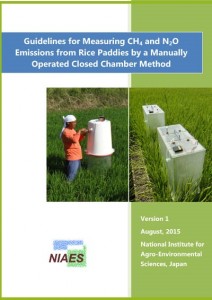The Institute for Agro-Environmental Sciences (NIAES-NARO) Japan, is pleased to announce the publication of a new handbook entitled Handbook of Monitoring, Reporting, and Verification for a Greenhouse Gas Mitigation Project with Water Management in Irrigated Rice Paddies.
The Handbook was planned as an action plan of PRRG and was cooperatively prepared by its members.
The National Institute for Agro-Environmental Sciences (NIAES) has announced the media release of the new publication, “Guidelines for Measuring Methane (CH4) and Nitrous Oxide (N2O) Emissions from Rice Paddies by a Manually Operated Closed Chamber Method”.
The guidelines are supported by the MIRSA-2 project “Technology development for circulatory food production systems responsive to climate change (Development of mitigation option for greenhouse gas emissions from agricultural lands in Asia)”, and funded by MAFF, Japan, to support the goals and objectives of the Paddy Rice Research Group of the Global Research Alliance.
UPDATE: New link to the 2020 revised guidelines
The Nitrous Oxide Chamber Methodologies page has now been added to the website. The full guidelines document can be downloaded on the page, or individual chapters. The document provides internationally agreed reference guidelines for measuring N2O emissions using chamber methodologies, so as to inform the production quality N2O flux measurement data and improve inter-comparability between international studies.
An article in support of the Paddy Rice Research Group – “Appropriate frequency and time of day to measure methane emissions from an irrigated rice paddy in Japan using the manual closed chamber method” has been published in the Greenhouse Gas Measurement and Management Journal. This research article is the first outcome for the Paddy Rice Research Group activity standardising measurements of greenhouse gas emissions from paddy rice. The next step for this research will be to compare data from irrigated rice paddies with different water management and tropical climates.
Kazunori Minamikawa, Kazuyuki Yagi, Takeshi Tokida, Bjoern Ole Sander & Reiner Wassmann (2012): Appropriate frequency and time of day to measure methane emissions from an irrigated rice paddy in Japan using the manual closed chamber method, Greenhouse Gas Measurement and Management, 2:2-3, 118-128.
Abstract
Rice agriculture is a large anthropogenic source of atmospheric methane (CH4). The reliable estimation of CH4 emissions requires frequent measurements to trace diurnal and seasonal variations. To evaluate the appropriate intervals and optimal time of day to measure CH4 emissions using the manual closed chamber method, this study analysed four datasets of CH4 fluxes in a Japanese irrigated rice paddy measured at 2-hour intervals using the automated closed chamber method. The typical diurnal variation in the CH4 flux was observed after the rice’s heading stage, during which the daily time-weighted mean CH4 flux was observed twice, in the 08:00–11:59 and 18:00–21:59 time windows. During the flooded rice-growing period, the CH4 emissions, which were estimated by weekly measurements once per day during the 10:00–11:59 time window, corresponded to 93–106% of the emissions calculated using the automated measurement method. In contrast, no regular measurement strategies produced a satisfactory estimate of the CH4 emissions during the non-flooded rice-growing period because of a sharp increase in the CH4 flux just after the drainage. Consequently, the combination of weekly measurements once per day at approximately 10:00 as local mean time for the flooded rice-growing period and daily measurements once per day during the daytime for 1 week after each drainage event is recommended as a strategy to obtain the estimation with a ±10% error.
Read the complete article: Greenhouse Gas Measurement and Management (subscription required)
